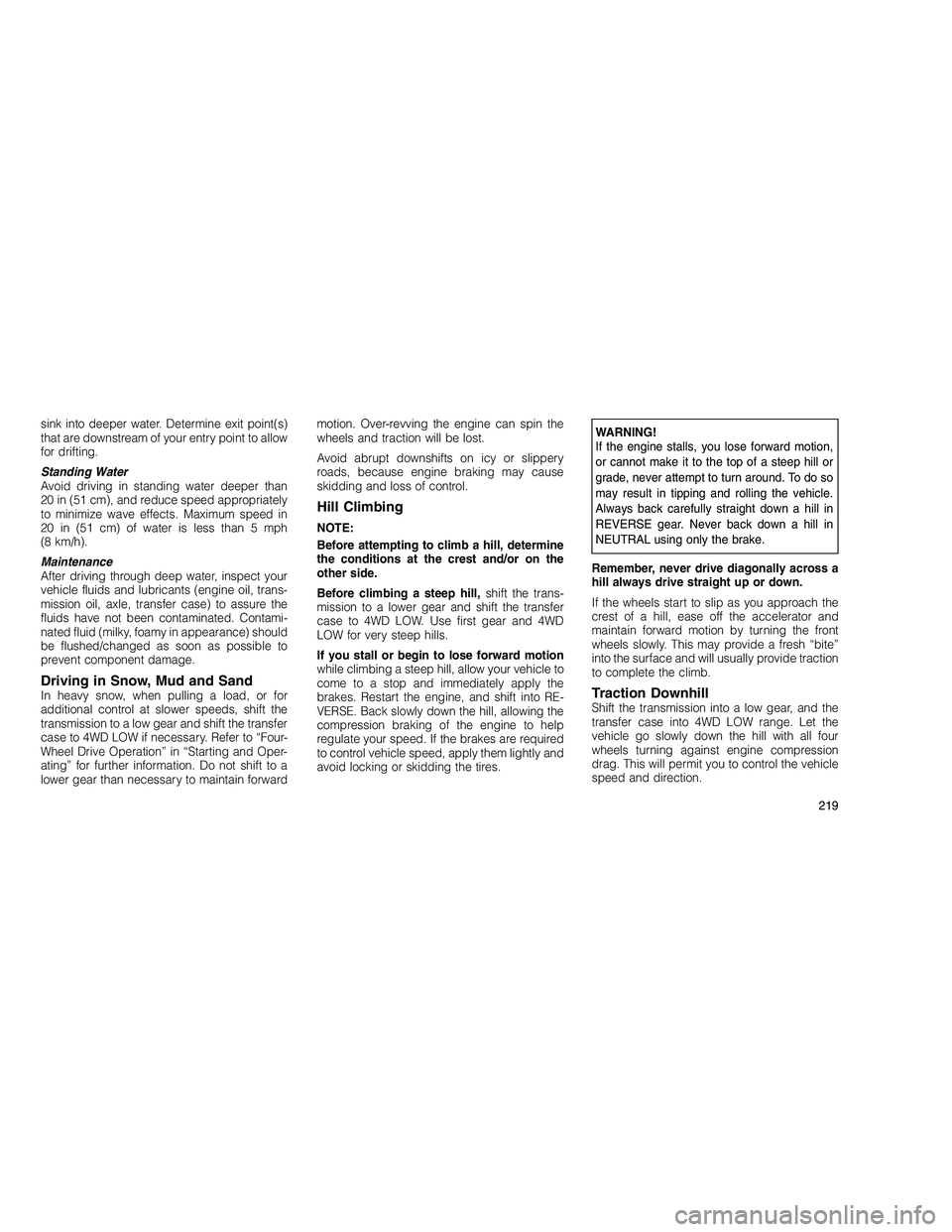compression ratio JEEP GRAND CHEROKEE 2010 Owner handbook (in English)
[x] Cancel search | Manufacturer: JEEP, Model Year: 2010, Model line: GRAND CHEROKEE, Model: JEEP GRAND CHEROKEE 2010Pages: 350, PDF Size: 4.58 MB
Page 223 of 350

sink into deeper water. Determine exit point(s)
that are downstream of your entry point to allow
for drifting.
Standing Water
Avoid driving in standing water deeper than
20 in (51 cm), and reduce speed appropriately
to minimize wave effects. Maximum speed in
20 in (51 cm) of water is less than 5 mph
(8 km/h).
Maintenance
After driving through deep water, inspect your
vehicle fluids and lubricants (engine oil, trans-
mission oil, axle, transfer case) to assure the
fluids have not been contaminated. Contami-
nated fluid (milky, foamy in appearance) should
be flushed/changed as soon as possible to
prevent component damage.
Driving in Snow, Mud and SandIn heavy snow, when pulling a load, or for
additional control at slower speeds, shift the
transmission to a low gear and shift the transfer
case to 4WD LOW if necessary. Refer to “Four-
Wheel Drive Operation” in “Starting and Oper-
ating” for further information. Do not shift to a
lower gear than necessary to maintain forwardmotion. Over-revving the engine can spin the
wheels and traction will be lost.
Avoid abrupt downshifts on icy or slippery
roads, because engine braking may cause
skidding and loss of control.
Hill Climbing
NOTE:
Before attempting to climb a hill, determine
the conditions at the crest and/or on the
other side.
Before climbing a steep hill,
shift the trans-
mission to a lower gear and shift the transfer
case to 4WD LOW. Use first gear and 4WD
LOW for very steep hills.
If you stall or begin to lose forward motion
while climbing a steep hill, allow your vehicle to
come to a stop and immediately apply the
brakes. Restart the engine, and shift into RE-
VERSE. Back slowly down the hill, allowing the
compression braking of the engine to help
regulate your speed. If the brakes are required
to control vehicle speed, apply them lightly and
avoid locking or skidding the tires.
WARNING!
If the engine stalls, you lose forward motion,
or cannot make it to the top of a steep hill or
grade, never attempt to turn around. To do so
may result in tipping and rolling the vehicle.
Always back carefully straight down a hill in
REVERSE gear. Never back down a hill in
NEUTRAL using only the brake.
Remember, never drive diagonally across a
hill always drive straight up or down.
If the wheels start to slip as you approach the
crest of a hill, ease off the accelerator and
maintain forward motion by turning the front
wheels slowly. This may provide a fresh “bite”
into the surface and will usually provide traction
to complete the climb.
Traction DownhillShift the transmission into a low gear, and the
transfer case into 4WD LOW range. Let the
vehicle go slowly down the hill with all four
wheels turning against engine compression
drag. This will permit you to control the vehicle
speed and direction. 219